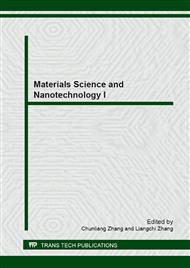p.242
p.246
p.250
p.254
p.258
p.262
p.266
p.272
p.276
Development of Triphasic Calcium Phosphate–Carbon Nanotubes (HA/TCP-CNT) Composite: A Preliminary Study
Abstract:
Triphasic calcium phosphate, composed of a more stable phase hydroxyapatite (HA) and highly soluble tricalcium phosphates (α- and β-TCP) has been synthesized through hydrothermal method. In the present work, an in-situ method to disperse 1wt% multiwall carbon nanotubes (MWCNTs) within HA/TCP powder has been used in order to develop HA/TCP-CNTs composite. XRD results confirmed the formation of HA, α-TCP and β-TCP in both as-prepared powder and composite samples. The graphite peaks appeared in the composite samples as well. FTIR analysis of sintered compacted powder showed the formation of weak bands of PO43- as the temperature was increased. The sintered compacts were mechanically tested by Vickers microhardness indentation method. HA/TCP-CNTs composite was found to have a significant of Vickers Hardness of 1.98 GPa after 1100°C sintering. The morphology analysis showed that in-situ deposition technique provides homogeneous dispersion of CNTs in the calcium phosphate matrix.
Info:
Periodical:
Pages:
258-261
Citation:
Online since:
December 2012
Authors:
Keywords:
Price:
Сopyright:
© 2013 Trans Tech Publications Ltd. All Rights Reserved
Share:
Citation:


